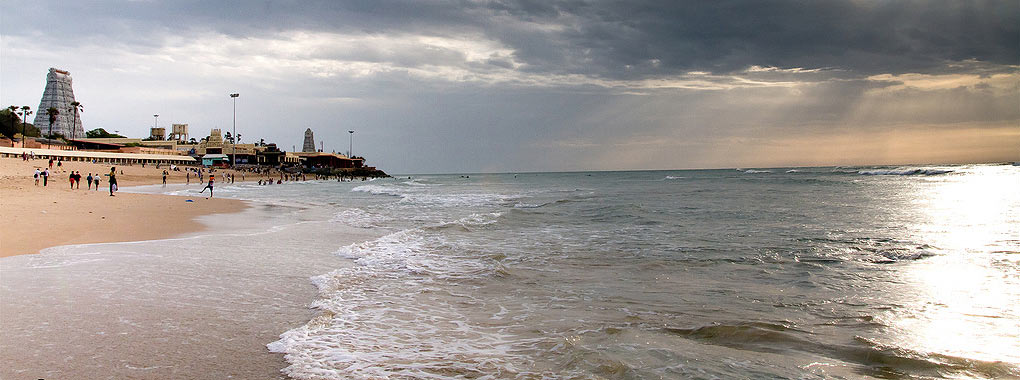The Temple at Tiruchendur

Arulmigu Subramaniya Swamy Temple
The Arulmigu Subramaniya Swamy Temple at Tiruchendur is a highly revered Hindu temple and a significant pilgrimage site in India. On the shores of the Bay of Bengal at the eastern end of Tiruchendur town in the Thoothukudi district of Tamil Nadu, it is believed to be one of the six major abodes of the Kaumaram religion.
The temple complex covers an area of about 10 acres and is situated on the shores of the Bay of Bengal. The main entrance of the temple faces the east and is adorned with a beautiful Rajagopuram or the tower at the entrance. It is 133 feet tall and has nine levels, each level adorned with intricate carvings and sculptures. The temple is believed to have been built in the 17th century by the Pandya king, Devaraja Mudaliar. The temple underwent several renovations and expansions over the years, with the latest one carried out in 1979.
When the Devas and Asuras, the celestial beings and demons, respectively, were at war with each other. The Devas, who were losing the battle, went to Lord Shiva and prayed for his help. Lord Shiva, in response to their prayers, created Lord Murugan and asked him to destroy the demon army.
Lord Murugan was born from Lord Shiva’s third eye as a powerful warrior, Lord Subramaniya Swamy, is depicted as a six-faced deity with 12 arms, riding on a peacock and carrying his signature weapon, the Vel, a spear-like weapon. He defeated the demon army, and the Devas could reclaim their rightful place in the heavens.
The temple has a rich history that dates back to the 2nd century BCE. It is believed that Sage Parasurama installed the idol of Lord Murugan here. Various kings and dynasties then renovated and expanded the temple, including the Chera, Pandya, and Chola dynasties.
The temple has a unique tradition of performing two major festivals: Soorasamharam and Kanda Shasti. Soorasamharam, which is a reenactment of the victory of Lord Murugan over the demon Soorapadman, is performed during the Tamil month of Aippasi (October/November). Kanda Shasti, a six-day devotional song in praise of Lord Murugan, is celebrated in the Tamil month of Aippasi (October/November).
The Dutch East India Company occupied the temple from 1646 to 1648, during their war with the Portuguese. The local people tried to free their temple, but their efforts were in vain. Dutch finally vacated the temple on orders from the Naik ruler. However, while leaving, they removed the sculpture depicting the 2 utsava murthis, made of an alloy named Shanmukhar, and took it with them.
During their sea voyage, they encountered a powerful storm and realised their mistake of stealing the murti. They dropped it in the middle of the sea and saw the storm stop immediately. Later, Senthil Aandavan appeared in a dream to Vadamaliyappa Pillai, an ardent devotee of Murugan, and revealed the place in the sea where the idol had been abandoned. Vadamlaiyappa Pillai went to the spot in a fishing boat and retrieved the murti in 1653.
The paintings inside the temple depicting the story of the retrieval of the idol add another layer of significance to the temple and provide an opportunity for the devotees to connect with the history and spirituality of the temple. The Arulmigu Subramaniya Swamy Temple at Tiruchendur is not only a place of worship but also a repository of history and spirituality, and the story of the retrieval of the idol is a testament to this fact.
Apart from the main deity, Lord Murugan, the temple also has shrines dedicated to several other deities, including Lord Shiva, Goddess Valli, and Goddess Deivanai.
The temple also has a beautiful beachfront, where devotees can take a dip in the sea and seek blessings. The beach is known for its beautiful sunrise and sunset views, making it a popular tourist attraction.
In conclusion, The Arulmigu Subramaniya Swamy Temple is not just a religious center but also a cultural and historical landmark. Its intricate carvings, stunning architecture, and serene surroundings make it a must-visit destination for anyone interested in exploring Tamil Nadu’s rich heritage.
“Temples are symbols of the human spirit’s innate need to seek something greater than themselves, not just physical structures.”
Follow My Blog
Get new content delivered directly to your inbox.

